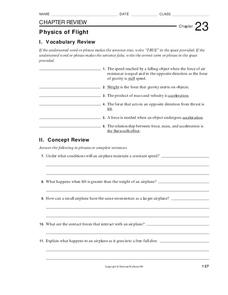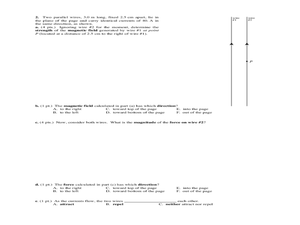Curated OER
Physics: Bounce - Projectile Motion and Collisions
Students conduct and observe experiments in Newtonian mechanics, kinematics, and projectile motion. They analyze the motion of a ball rolling off a table, falling, and then bouncing. Students answer a series of questions analyzing the...
Curated OER
Elements of Physics: Motion, Force and Gravity
High schoolers research about different human space explorations conducted by NASA. In this physical science lesson, students discuss why space exploration is important. They write a paper about their thoughts on continuing NASA's space...
Curated OER
Weight A Minute
Students watch a video and engage in hands-on activities which introduce scientific information made real through re-cognition and understanding the phenomena of gravitational force and how it impacts life on our planet.
Curated OER
The Parachute
Young scholars discuss parachutes and write a procedure to determine the effect of different size parachutes and different masses on the time it takes the masses to fall. They record all their data from their experiment then write three...
Curated OER
Force Counterforce
Students hypothesize what forces affect the motion of a falling body. In this physical science lesson, students create diagrams and illustrations to support their hypothesis. They perform the experiment and record observations.
Curated OER
Build Your Own Parachute
Students study the basics of parachuting. In this flight and aerodynamics lesson plan students make a simple parachute and investigate different variables that can cause potential problems.
Curated OER
Physics of Flight
In this flight worksheet, students will review the physics behind flight including lift, acceleration, and thrust. Students will also understand the Bernoulli effect. This worksheet has 6 true or false, 6 short answer, and 8 matching...
Curated OER
Lesson-Mass and Weight
Student identify the three stationary positions, on the Earth, on the Moon, and in a house floating atop the cloud layers of Jupiter. They also identify the three orbiting positions, orbiting the Earth, orbiting the Moon, and orbiting...
EngageNY
Modeling with Quadratic Functions (part 1)
Relevance is key! The resource applies quadratic modeling by incorporating application of physics and business. Pupils work through scenarios of projectile motion and revenue/profit relationships. By using the key features of the graph,...
Curated OER
Worksheet 2 - Instantaneous Velocity
In this distance worksheet, students determine the distance between two objects, find the average velocity of an object, and define instantaneous velocity. This two-page worksheet contains six two-step problems.
Curated OER
Projectile Motion Demonstration
Students dicusss Newton's First Law of Motion. They calculate a projectile moving horizontally and vertically at different intervals. They particpate in an experiment in which the projectile is at an angle. They record and discuss the...
Curated OER
Galileo: His Times & Beliefs
Students study Galileo and his scientific discoveries. They complete a series of experiments/model constructions, using 17th century equipment and procedures, to "recreate," demonstrate and explore the various discoveries of Galileo.
Cornell University
Catapults
Ready, aim, fire! Launch to a new level of understanding as scholars build and test their own catapults. Learners explore lever design and how adjusting the fulcrum changes the outcome.
Curated OER
Force & Motion
Third graders are introduced to the concepts of force and motion. In groups, they travel between stations to analyze the effect of force and motion on various objects. They research how various careers use these concepts as well.
Curated OER
The Ups and Downs of Weight and Mass
Pupils explore the concept of mass, and how it differs from weight. They also calculate their weight change as they ride up and down on an elevator. They record the changes in their weight as the elevator moves
graph the collected data.
Curated OER
Physics Midterm Exam #2
This comprehensive midterm exam covers a vast array of topics typical to high school physics curriculum. Problem solving and mutliple choice questions are incorporated. Review the exam to make sure that the content is suitable to your...
Curated OER
#24 Rotating Frames of Reference in Space and on Earth
Learners explore rotating frames of reference, focusing on the weightless environment in space and the Coriolis force.
Curated OER
Circles in the Landscape: Irrigating Oklahoma Crops
How do you grow crops in a area with insufficient rainfall? Why you irrigate, of course. Class members investigate irrigation systems by designing a system of their own. After examining irrigation related concepts, vocabulary terms, and...
PBS
Pbs Learning Media: Free Falling and Weightlessness
Discover the difference between free-falling and weightlessness in this interactive activity from the NOVA: "Stationed in the Stars" Web site.
Physics Classroom
The Physics Classroom: 1 D Kinematics: Representing Free Fall by Graphs
In this physics tutorial, the motion of a free-falling motion will be represented using position versus time and velocity versus time graphs.
TED Talks
Ted: Ted Ed: Free Falling in Outer Space
With a little help from Sir Isaac Newton, Matt J. Carlson explains the basic forces acting on an astronaut during a free fall. [2:59]
Science Education Resource Center at Carleton College
Serc: Investigating the Constancy of Gravity: Free Fall Using a Water Bottle
In this physics interactive lecture demonstration, students will predict what will happen if a plastic bottle, filled with water and having a hole near the bottom, is dropped. Will the bottle fall at the same rate as the water inside the...
Texas Education Agency
Texas Gateway: Kinematics: Falling Objects
By the end of this section, you will be able to describe the effects of gravity on objects in motion, describe the motion of objects that are in free fall, and calculate the position and velocity of objects in free fall.
Physics Classroom
The Physics Classroom: Elephant & Feather (Free Fall)
A demonstration involving an elephant and a feather and explanation of why all objects maintain the same acceleration in the state of free fall without any air resistance.























